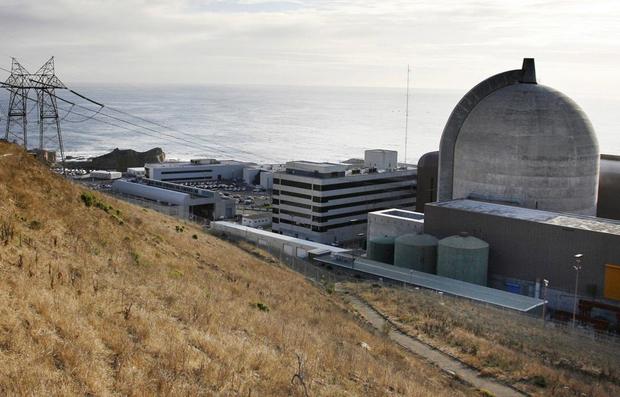California ponders extending life of state's last operating nuclear plant beyond 2025
California Gov. Gavin Newsom on Friday proposed extending the life of the state's last operating nuclear power plant by at least five to 10 years to maintain reliable power supplies in the climate change era.
A draft bill obtained by The Associated Press and which Newsom's office confirmed said the plan would allow the plant to continue operating beyond a scheduled closing by 2025.
The bill says impacts of climate change are occurring sooner than anticipated and are simultaneously driving up electrical demand while reducing power supplies.
"The governor has been clear for months about the potential need to extend the life of Diablo Canyon," said Anthony York, a spokesperson for Newsom. He added that Newsom's administration has stressed the need to keep all options on the table to maintain reliable power and that "this proposal reflects the continued need to keep that flexibility."
The draft proposal also includes a possible loan for operator Pacific Gas & Electric for up to $1.4 billion.
Three weeks to decide
The state's legislature has less than three weeks to determine if it will take an extraordinary step and attempt to extend the life of the state's last operating nuclear plant, a decision that would be made amid looming questions over the cost, who would pay it and earthquake safety risks.
With an extended run, "Who pays, and is there fairness in who pays?" Laird asked in an interview. "There have been additional earthquake faults discovered near the plant, and seismic upgrades were never totally completed. Will they address that?"
The legislative session shuts down August 31, when all business is suspended, and only a rare special session called by Gov. Gavin Newsom could provide a longer period to consider the move. The Democratic governor, seen as a possible future presidential candidate, has urged operator Pacific Gas & Electric to pursue a longer run beyond a scheduled closing by 2025, warning that the plant's power is needed to maintain reliable service as the state transitions to solar, wind and other renewable sources of energy.
The draft was obtained before a scheduled California Energy Commission hearing focused on the state's power needs in the climate change era, and what role the decades-old nuclear plant might have in maintaining reliable electricity in the nation's most populous state.
Newsom's plan was met by immediate criticism from environmentalists who called it a huge financial giveaway for PG&E that pushes aside state environmental safeguards.
If approved, the state would "give PG&E over $1 billion in loans at below the interest rate even state agencies charge among themselves, and it's completely forgivable," said David Weisman, legislative director of the Alliance for Nuclear Responsibility, an advocacy group.
Weisman asked: "What are taxpayers in Southern California getting out of this?" PG&E's service area is concentrated in Northern California.
Also raising questions with Newsom is state Sen. John Laird, a Santa Cruz Democrat whose district includes the seaside plant located midway between Los Angeles and San Francisco.
Laird outlined other issues that include who would pay for delayed maintenance on the plant; whether there is time for PG&E to order and receive additional radioactive fuel — and casks to store spent fuel — to keep operating; and would electricity from the reactors get in the way of transmission for wind power that is expected to come on line in coming years.
Expansion would require much money, scrambling
Potentially, billions of dollars in costs could be in play.
"I'm really waiting to see whether ... and how they address all the issues that are associated with a possible extension before I decide what I'm going to," Laird said, referring to a possible vote.
"We are under a tight timeframe," Laird added. "That begs the question of could they do everything it needs to be extended by 2025?"
Nuclear power doesn't produce carbon pollution like fossil fuels, but leaves behind waste that can remain dangerously radioactive for centuries. Some environmentalists have embraced nuclear power as a reliable electricity source that doesn't produce greenhouse gases, while others point to the potential for radioactive disasters.
For Diablo Canyon, the issue is whether the Newsom administration, in concert with investor-owned PG&E, can find a way to unspool a 2016 agreement among environmentalists, plant worker unions and the utility to close the plant by 2025. The joint decision to close the plant also was endorsed by California utility regulators, the Legislature and then-Democratic Gov. Jerry Brown.
PG&E CEO Patricia "Patti" Poppe told investors in a call last month that state legislation would have to be enacted by September to open the way for PG&E to reverse course.
PG&E: Plant is seismically safe
PG&E, which has long said the plant is seismically safe, hasn't said much about whether it will push to extend operations beyond 2025. It is assessing that possibility while continuing to plan for closing and dismantling the plant "unless those actions are superseded by new state policies," PG&E spokesperson Suzanne Hosn said in a statement.
Another major question is whether Newsom and the Legislature might try to sidestep regulatory agencies that have oversight of the plant, including the powerful California Coastal Commission. The plant's massive cooling system relies on submerged ocean water intake and discharge structures.
PG&E also would have to obtain a new operating license from the Nuclear Regulatory Commission to run beyond 2025.
With so many pending issues and little time, "it is rushed. It does not make sense," said David Weisman, legislative director of the Alliance for Nuclear Responsibility, an advocacy group.
"The plant can't run a day longer than the NRC license," which expires in August 2025, Weisman added.
Newsom's push for a longer run for the reactors doesn't square easily with his assessment in 2016, when as lieutenant governor he supported the closure agreement as part of the State Lands Commission.
Seismic issues at the plant "are not insignificant concerns," he said at the time. "This is not the preeminent site if you're ... concerned about seismic safety."




